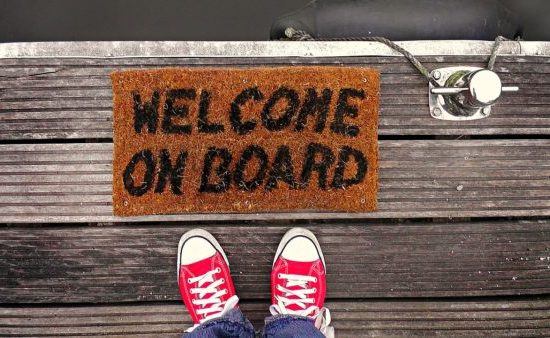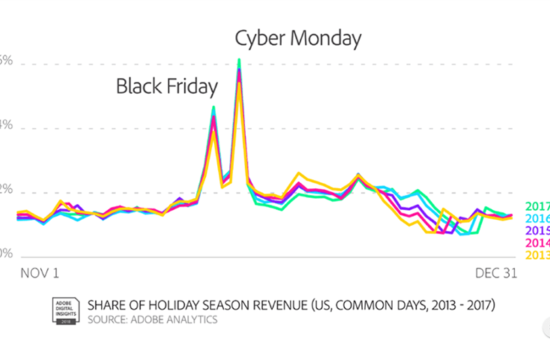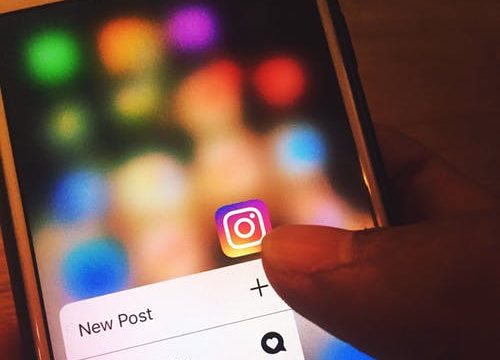
With 3.196 billion people using social media from the moment they crack open one eye in the morning to the time they doze off scrolling through Instagram, you can’t take the risk of disregarding the social platforms as viable customer acquisition channels.
Everybody and their grandma is on social media. Your existing customers, your potential customers, and your competitors are already there. Leverage these social channels to bring new life to your lead generation campaigns and usher them down the sales funnel.
Same goes for your referral marketing campaign.
Don’t launch your e-commerce referral program without a solid promotional strategy in place. Lack of proper awareness will lead to your campaign falling flat on its face. You need to have an integrated marketing strategy in place with enough resources to promote your campaign on all available channels, including social media.
Continuing along that train of thought, your promotion game plan should be a part of the existing social media marketing strategy. Your audience won’t appreciate on-your-face promotional posts; you have to build up authority to induce trust and boost engagement. A study shows that 51% of participants would unfollow brands on social media if they posted irritating posts and 27% would mark/report the brand and page as spam and block them. Offering incentives isn’t enough to solicit referrals, you need to feel the pulse of the crowd and appeal to them in their own language.
Conduct a thorough demographic and psychographic research, and craft your marketing messages in the same voice and tone as your target group, but ensure that it’s aligned to your brand voice and positioning.
Sure-fire ideas to promote your referral program on social channels
The intention behind a referral program for your loyal customers is to delight them and keep them hooked. They are your best unofficial brand advocates and their recommendations will go a long way in securing a steady stream of qualified referrals.
Below are the primary factors that you should consider while planning a referral program for them
- The products/services they showed interest in,
- The channels where they are talking about your brand
- The channels where they are sharing their purchases
- The kind of incentive they’d appeal to them
Find the hangout spots: Determine where they spend most of their online time. You can send out surveys, use social listening tools such as Hootsuite or Mention to monitor where people are talking about your brand, use Google Analytics to track where your site visitors are coming from, and study the demographics of social media users to get a fair idea of the trending social channels.
Track their behavior: Track their purchase pattern, abandoned cart, and wishlist items. The referral program should be framed in such a way so as to encourage the one-time/regular buyers to repurchase and continue/kick-start the practice of referrals.
Offer them discounts on the wishlist items, in exchange for referrals. Create time-bound referral campaigns to induce FOMO and boost immediate purchase.
Take surveys, try to analyze the reason behind the cart abandonment and offer exclusive rewards with personalized messages to remind them of the products. For example, if the shipping prices are too high, offer them free shipping if they manage to convert one of their friends.
Here’s how you can do it:
You can use Facebook Retargeting Ads, Adroll, or AdWords Remarketing Ads to attract the buyers by showing them items that they had checked out previously.
Behavioral Retargeting Ads such as Dynamic Product Retargeting Ads helps in customization; these ads display the products that the buyers had shown interest in.
Abandoned Cart Retargeting Ads are used to remind them of the items they had added to cart previously; to push them towards completing the purchase.
Sequential Retargeting Campaigns help in reducing ad fatigue by showing different ads with varied messages over a period of time. For example, You can display different rewards or referral conditions each week to capture the attention of the potential customers, compelling them to make the first transaction and start referring.
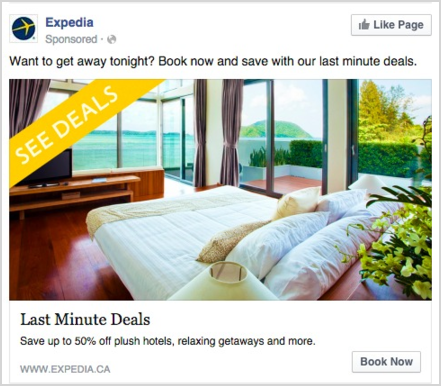
Check out this retargeting ad by Expedia. You can add creative copy on the image (following the 20% rule), and customize the description, title and FB content to push the buyer to refer for the enticing reward that awaits them.
These ad campaigns will help you create hyper-relevant referral program by targeting the referrers with products they have already shown interest in. By providing discounts on these products in exchange for referrals, you are eliminating the need for testing different incentive structures.
Life Events: Use Facebook’s “Life Events” feature to target people with upcoming birthdays/anniversaries, or those who have landed a new job and customize your brand message to advertise your referral program to them.
For example, if you sell home decoration items, and you target the newly married demographic, you can offer sizeable discounts on important household items as rewards for referrals.
Segment and target: Based on their interests, segment the customer lists and reach out to them with a referral request whenever a new product that they might like is added. Similarly, if the price drops for the items they have checked out in the past, create ads for them and pitch your referral program. Create a list of your top customers and introduce a tiered reward program especially for them. Show them personalized ads to encourage them to refer more.
Make sharing easy: Offer your customers ways to share their referral messages easily. In the transaction or marketing emails provide them with social buttons (Facebook, Messenger, Twitter, etc) to share their coupon codes with others. Pre-populate the shareable message, but leave space for personalization so that they can tag people, or spread the word in their own style.
Plan ahead for time-based programs: Keep an eye on the calendar before planning referral posts. If you are offering time-based rewards, make sure you promote it enough before the D-day. For example: If you are planning to offer 2x referral rewards on Black Friday, the promotional posts should be circulated for 2 weeks before that.
Appreciate your referrers: Acknowledge your regular referrers on social media. Promote them via your brand profiles and surprise them with unexpected and meaningful rewards to nurture and build long-lasting relationships. This will not only warm them up towards your brand but also encourage them to partake in advocacy actions. If you have a loyalty program in place, this might be a good time to invite them to participate.
Go for indirect referrals: Lay the foundation for indirect referrals just for your social media audience to bring more people to your profile, to accrue more followers and improve the credibility score.
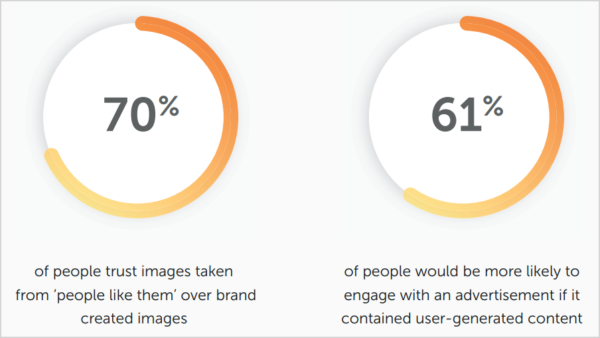
For example, run a campaign for those customers who’d share their purchases online. Buyers, as a rule, will trust authentic posts by real people more than snazzy brand messages. Utilize this behavior to drive potential customers to your online store and track their activity for future targeted ads.
Instead of creating ads, you can try sponsoring the user’s referral posts to capture their network’s attention. It will help you market your products and promote the referral program, sans the sales-y tone that your audience dislikes.
Come up with a branded hashtag, and ask your fans to share their purchase pics on social media with that hashtag. Display those user-generated posts on your website to boost social proof.
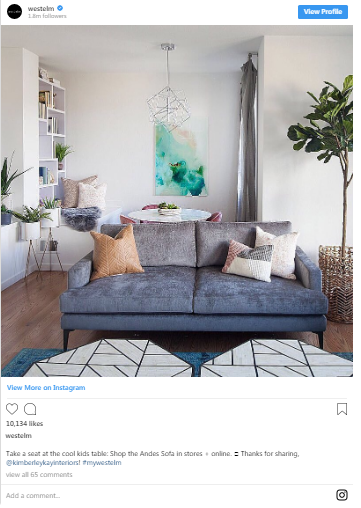
Pair-up: Partner up with a non-competing brand in your industry to offer an exclusive reward package of popular products as an incentive for a considerable number of referrals. Promote the posts extensively on all social channels to rope in the audience base of both the brands.
Bring out the big guns: Work with social influencers to take your referral program one step further. Identify the influencer whom your target group follows, and who’d be the perfect fit for your brand in all respect. Generate unique codes for them, ask them to promote your campaign on their channels and to share their code with the followers. Create video contents featuring the influencer – testimonials, reviews, unboxing videos etc for maximum exposure.
If you’re wary of employing influencers, you can go for a strategy that did well for Glossier. They have an official representative program for their top customers or ‘evangelists’ who create excellent content for the brand on social media. They even have their own pages where they share their product recommendations, and others can purchase directly from there. As incentives, the reps get monetary commissions or store credits. As the founder of Glossier, Emily Weiss said in the article, “It’s basically the referral program on steroids…It comes back to making everyone an influencer…and so we’re building a platform that enables that.”
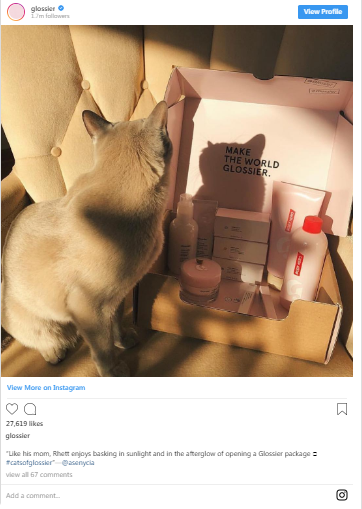
Glossier regularly reposts snaps of their reps showcasing the products.
Monitor and respond: 96% of the people that discuss brands online do not follow those brands’ owned profiles. Hence, monitor. Listen for conversations around your brand, especially for the complaints regarding your referral program. For example, if someone didn’t get the promised reward and is venting out, offer assistance as soon as possible – 77% of Twitter users feel more positive about a brand if they reply to their tweets.
Make use of Twitter Advanced search to find and respond to relevant tweets. Track the popular hashtags relevant to your industry via tools such as Hashtagify and add those to your referral post to gain more traction.
Go multi-channel: Adopt a multi-channel approach to cover more ground. Create entertaining Instagram stories to talk about the referral program and display the rewards. Re-post it on other channels and provide the link to the specific referral landing page. Use your most popular product images and create Instagram carousel ads to compel your audience to stop scrolling and check out your offerings. You can do the same for Facebook. If you are active on Snapchat, create stories there and re-post on Twitter or Facebook to make your overlapping audience aware of your presence on the other channels.
Don’t forget the basics: Find out the best times to post on different social media channels. Design specific cover pictures optimized for each channel and add a link to your referral landing page in the bios. Also, pin the referral posts to the top of the profiles.
Last, but not the least –
Do. Consider. Pinterest.
Your e-commerce brand needs Pinterest to increase site traffic and boost awareness. If your target audience frequents Pinterest, chances are you will also find a vast array of lookalike audience to amplify your referral campaign. I’ll just casually drop some stats that’ll help you understand the magnitude of the selling power of Pinterest –
- Pinterest helps 90% (sample size 4061) of pinners to decide what to purchase
- 78% say it’s useful to see contents from brands on Pinterest, and
- 66% buy something after seeing a brand’s pins.
Also,
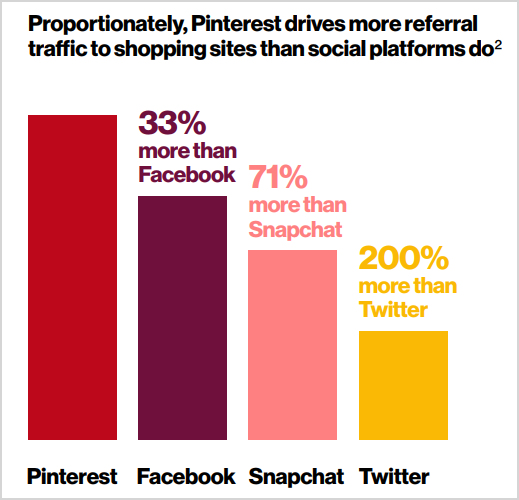
Pinterest offers brands to display and sell a wide range of products, segment those into boards for easy navigation, and appeals to the audience who display buyer intent. Even for research purpose, you will get a fair idea of the interests and preferences of your target audience by the content of their boards.
Most importantly, your potential buyers can buy directly from Pinterest with the help of Rich Pins. Product Pins will provide them with all the required information about the product, and they can purchase any product directly via Buyable Pins. Also, if a user saves a buyable pin for later, they will get a heads up if and when the price drops in the form of an in-app notification and an email.
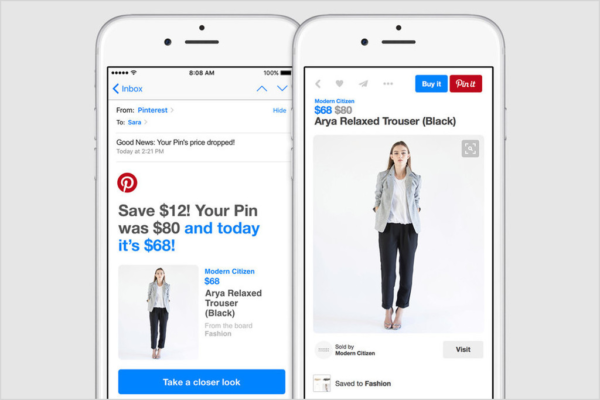
- Make use of Promoted Pins to tell the world about your referral campaign. Create optimized, high-quality, aesthetically pleasing posts to grab more eyeballs.
- Create buyable pins of the new and popular products that your audience have shown interest in, and offer discounts on them in exchange for referrals. Write a brief description, linking to the referral landing page and create a clear CTA or your audience to follow.
- Post videos of your influencer referral program and promote it with paid advertisement program to amplify its reach.
- Invite your fans to contribute to your community/UGC board. They can pitch in to populate the board with snapshots of the products/of them using the product. Add an intro to your referral program to each of those pins along with the landing page link.
Wrapping up,
Planning a balanced social media strategy, building a community and staying engaged incessantly is not an easy feat. However, once you hit the sweet spot, you’d be able to unlock a wide range of online audience. Even if your referral program is the next big thing, it needs to be brought in front of people to get more qualified buyers on board. Social media offers you the platforms to hype up your campaign and drive your e-commerce sales via direct and indirect referrals.
Author : Pritama Sarkar
Pritama is the Product Marketer and the resident ‘crazy content lady’ at AppVirality. She writes, curates, strategizes and stalks dogs on Instagram. If she’s not in her seat slouching over her laptop, she’s most probably taking a power nap somewhere.






